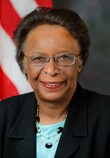Remarks

Dr. Cora Marrett
Deputy Director
National Science Foundation
Biography
Remarks at the
U.S.-Israel Binational Science Foundation Dinner
The Israeli Embassy
Washington, DC
January 28, 2014
Mr. Deputy Ambassador, thank you for hosting this reception and dinner for the Binational Science Foundation. I very much appreciated your reference to planting carob trees, which may take 70 years to produce fruit. Many of our scientific investments may also take a long time to bear fruit, and this intellectual harvest will likely be reaped by today's students and early career scientists. After our earlier meeting today at the National Science Foundation, where we worked through the serious and substantive issues facing the BSF, now we will have the opportunity to renew friendships and catch up on more personal matters. This is the perfect way to end a day devoted to cooperation and collaboration.
When one looks back at the 40-plus years of its history, it is apparent that BSF is one of those rare organizations that started with a great idea--and just gets better and better with each passing year.
As Dr. Rotstein mentioned, the BSF was created in 1972 with the objective to "promote and support cooperation between Israel and the United States in research in science and technology for peaceful purposes on subjects of mutual interest."
I believe the crafters of the original agreement setting up BSF would be very pleased--and delighted--at the progress both nations have made in realizing the agreement's objective. In the American vernacular, this is what we would call a "win-win" for both our governments.
With just a modest investment of resources, BSF has directly or indirectly achieved extraordinary dividends. In numerous fields of scientific endeavor--from basic biological sciences to computer science to mathematics--U.S. and Israeli scientists funded through BSF have made and are continuing to make significant intellectual contributions. These contributions are improving health care, economic development, environmental stewardship, and more.
One indicator of the quality of the research BSF gets for its investments is that BSF has a habit of supporting Nobel Prize winners as well as winners of the Lasker and Wolf Prizes. Obviously, BSF has a keen eye for spotting emerging scientific talent and selecting cutting-edge, highly meritorious proposals. As the Acting Director of an organization that evaluates tens of thousands of funding proposals annually, I can say this ability to choose scientific "winners" is a rare gift indeed.
What is the secret of BSF's success? Close collaboration is certainly one explanation, but "collaboration" doesnt fully explain the process of how decisions are made. I think the secret is more accurately described as "cross-fertilization" between highly experienced scientific professionals. Working together in an atmosphere of limited resources but unlimited expectations, BSF's decision-makers find innovative ways to support the most promising scientific research.
And while it is reassuring to reflect on BSF's prior achievements, we always need to be looking to the future--we need to be planting those carob trees. We need to build on BSF's past successes, leveraging these successes to deepen our collaborations and nurture the next great achievements of U.S.-Israeli researchers.
One way to do this, especially in an era of tight budgets, is to support innovative partnerships. One such BSF partnership is with the U.S. Department of Energy for research in alternative and renewable energies and energy efficiency.
Other examples are the BSF-NSF Joint Programs in Chemistry, Biology, and Computer Science.
We hope to announce other joint funding programs in the near future. These types of partnerships expand the reach of both funding agencies in a manner that provides for scientific excellence and deeper scientific collaborations.
In addition to deepening scientific collaborations, BSF programs also need to nurture students and early career researchers. At the National Science Foundation, support for human capital programs is one of our highest priorities. Our philosophy is that if we scrimp on support today for students, postdocs, and young principal investigators, we are--in effect--not providing the "seed corn" for the next generation of researchers. In this regard, BSF human capital programs like the Start-up Research Grants and Rahamimoff Travel Grants provide important opportunities for students and early career investigators. With science becoming increasingly international, the more international experiences we give our young researchers, the more productive they will be in their careers. With these programs, BSF is supporting the next wave of US-Israeli collaborations and helping the next generation of Israeli scientists to reap the benefits of today's scientific discoveries and plant their own "carob trees" for future generations.
I could go on for hours about the great achievements and great prospects of the Binational Science Foundation, but I know we're all looking for forward to the performance of the Silverwinds Ensemble and the presentation of the Bergman Prize. So let me close with a personal observation:
It is commonly acknowledged that we live in an increasingly globalized world. Challenges such as climate change, natural disasters, rising ocean levels and widespread malnutrition do not stop at national borders or the water's edge. Cross-national collaborations are essential to tackling these and other global science and engineering challenges. The Binational Science Foundation is providing an outstanding model for other countries and governments as they seek to find ways to advance scientific knowledge and contribute to the progress of humankind.
Thank you again, Mr. Deputy Ambassador, for your hospitality, and thank you all for your contributions to the success of BSF.


